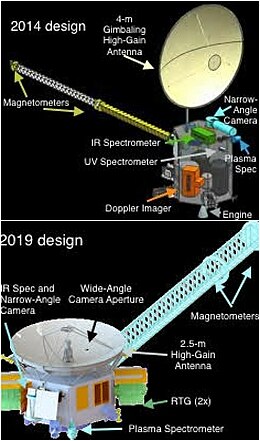 Comparison of two designs for Trident | |
| Mission type | Reconnaissance, flyby of outer planets |
|---|---|
| Operator | NASA |
| Mission duration | 13 years (planned) |
| Start of mission | |
| Launch date | Proposed: 25 October 2025 (with a backup in October 2026)[1] |
| Flyby of Earth (gravity assist) | |
| Closest approach | 28 October 2026[2] |
| Flyby of Venus (gravity assist) | |
| Closest approach | 25 March 2027[2] |
| Flyby of Earth (gravity assist) | |
| Closest approach | 7 February 2028[2] |
| Flyby of Earth (gravity assist) | |
| Closest approach | 7 February 2031[2] |
| Flyby of Jupiter, Io (gravity assist) | |
| Closest approach | 28 June 2032[2] |
| Distance | 1.24 RJ or 88,650 km (55,080 mi) |
| Flyby of Neptune, Triton | |
| Closest approach | 28 June 2038[2] |
Trident is a space mission concept to the outer planets proposed in 2019 to NASA's Discovery Program.[3][4] The concept includes flybys of Jupiter and Neptune with a focus on Neptune's largest moon Triton.
In 2020, Trident was selected along with three other Discovery proposals for further study, with two expected to be selected to fly as Discovery 15 and 16.[5] On 2 June 2021, NASA selected the Venus missions DAVINCI+ and VERITAS over Trident and the Io Volcano Observer.[6]
- ^ Cite error: The named reference
Triton 2025was invoked but never defined (see the help page). - ^ a b c d e f Cite error: The named reference
Trident_Detailswas invoked but never defined (see the help page). - ^ NASA proposes mission to Neptune moon Triton. Paul Scott Anderson, EarthSky 28 March 2019.
- ^ Cite error: The named reference
Trident_Descriptionwas invoked but never defined (see the help page). - ^ "NASA Selects Four Possible Missions to Study the Secrets of the Solar System". NASA. 13 February 2020.
 This article incorporates text from this source, which is in the public domain.
This article incorporates text from this source, which is in the public domain.
- ^ Potter, Sean (2 June 2021). "NASA Selects 2 Missions to Study 'Lost Habitable' World of Venus" (Press release). NASA. Retrieved 2 June 2021.